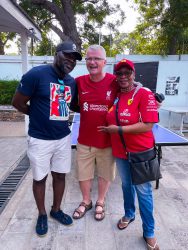In the early 1980s, Lou Gerstner led a transformation strategy that significantly improved the fortunes of American Express Travel Related Services (AmEx TRS). He altered the team’s outlook and the business’s focus, expanded the range of products and services, catered to ignored segments and created a more entrepreneurial work environment.
The team implemented these measures during a period of intense competition in a mature market when the business struggled to survive. By end of the decade, results were evident as the company achieved exceptional growth in net income and return on equity. In hindsight, this is a straightforward process. I presented the case to young professionals in a Graduate Management Training Programme. One participant claimed the actions were ordinary and not worthy of being called a strategy.
Last June, Jon Moeller discussed Procter & Gamble’s successful strategy for achieving excellent results in the previous five years despite global economic challenges. They began to focus on both top and bottom lines, redefined market share growth, and reshaped their brand portfolio from 220 to 65 in line with their growth aspirations. In the recent past, the business had not achieved the success they believed they could achieve. They needed to do something different. They needed a new strategy.
Four decades apart, the two companies mentioned above faced common problems: competition, mature markets, etc. Did their successes stem from superior strategies? If so, success-generating strategies are simple, not complex. In both cases, the companies made choices different from their recent past. What prevents other businesses from achieving sustainable success? What makes the strategy dance complicated?
The challenge of crafting effective strategies
Every business plays an infinite game and operates in a constantly evolving context (technology, demographics, regulation, etc.) that shapes the company’s fortunes. Success depends on adapting quickly to changing conditions. As Henry Mintzberg pointed out: “The real challenge in crafting strategy lies in detecting subtle discontinuities that may undermine a business in the future. And for that, there is no technique, no programme – just a sharp mind in touch with the situation”.
He downplays the need for templates, maps and frameworks that have dominated strategy thinking but not yielded any meaningful result. A practical approach is necessary to develop “a sharp mind in touch with the situation”. It’s about learning and adaptability rather than dwelling on past strategies.
Strategy is learning and defining new realities
Peter Senge states: “A deep and consistent commitment to learning allows organisations to discern non-obvious areas of leverage“. The curiosity to stay in touch with ever-evolving realities of the marketplace demands humility, courage and discipline. Humility helps us accept others’ perspectives and acknowledge what we don’t know. Leaders and strategists will need the courage to ask fundamental questions that put the past in all its glory under the microscope.
The constantly changing context requires leaders and strategists to remain curious and disciplined. This ensures they prioritise customers over competitors and act on marketplace realities.
Strategy is gaining clarity about the business context
Learning leads to clarity, which is critical for successful strategies. Cynthia Montgomery puts it this way: A great strategy, in short, is not a dream or a lofty idea but rather the bridge between the economics of a market, the ideas at the core of a business, and action. To be sound, that bridge must rest on a foundation of clarity and realism, and it also needs a real operating sensibility.
Models like Michael Porter’s Five Forces help us better understand the industry-economics and ideas at the core of the business (which is supposed to serve the customer), not the strategy. Leaders and strategists must ask fundamental questions such as:
- What change do we seek to make in customers’ lives, and what can we do today that offers value to them in a meaningful way?
- What assumptions have we made about the business and its economics, and what is the basis of these assumptions?
- What do we know to be true about the team, business and industry today, and how do we avoid being trapped in the past?
- What’sthe organisation’s culture, and what are we willing to change?
Gerstner and Moeller led their teams to ask these important questions and developed unique insights, which became the basis for their strategy. They challenged their assumptions about what should be the focus of AmEx TRS and P&G.
Strategy is making consistent choices
Empathy for the customer and curiosity are essential factors in a successful strategy. Organisational learning creates clarity and provides a foundation for choice-making. These choices must be consistent and lead to meaningful outcomes. Roger Martin offers a set of interrelated questions that must guide choices in the strategy development process. These are:
- What is your winning aspiration? The purpose of your enterprise, its motivating aspiration
- Where will you play? A playing field where you can achieve that aspiration
- How will you win?
- What capabilities must be in place?
- What management systems are required?
A strategy is effective when the choices uniquely position the organisation to have a relevant point of difference for chosen customers and win in the marketplace.
Strategy is engaging in an ongoing change and renewal in service to the customer
Implementing new strategic choices starts a change process that leads to organisational renewal. Developing and applying new behaviour, systems and approaches to support the newly adopted strategies requires time and learning.
As John Kotter suggested: “Transformation is a process, not an event”. Leaders must create the conditions for new insights to be translated into action as quickly as possible. Ultimately, individuals must change and lead with the new strategy to guarantee success.
Making effective strategic choices in the marketplace requires continuous learning. In that sense, the most effective strategy is to build an adaptive learning organisation capable of sensing and responding to changes in its context in service to the customer. Don’t be surprised. Many will always consider your strategy impossible until it’s done.
…..be of good cheer!
>>>The writer is a Leadership Development Facilitator, Executive Coach and Strategy Consultant, Founder of the CEO Accelerator Programme, and Chief Learning Strategist at TEMPLE Advisory. The mission of The Leadership Project is to harvest highly effective leadership practices and share them in a manner that other leaders can easily incorporate into their leadership practice. If you have an idea or leadership practice to share, kindly write to [email protected]. Until you read from us again, keep leading…..from leader to leader, one practice at a time.









